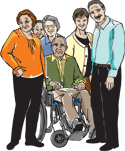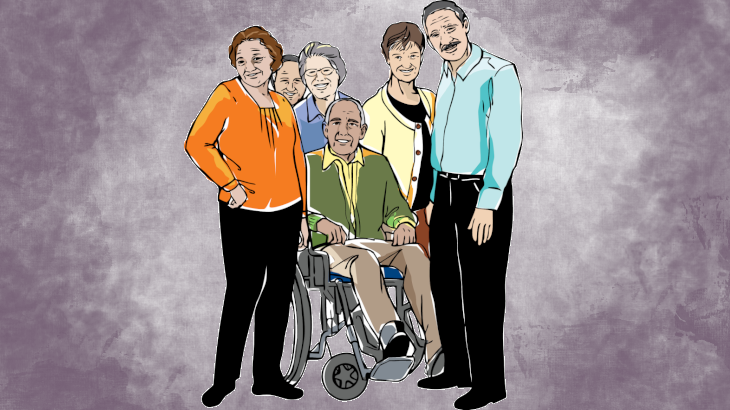Last month, we reviewed some of the local options for seniors who wish to remain in their homes. This month, we focus on different types of care, both in the home and in a facility. These might look different depending on the location, but there are some commonalities.
Support Services
As we age, it might be necessary for those wishing to remain in their home to have additional support. These supports are lumped into a group commonly referred to as “support services”. Here are some of those services and what they mean:
- Personal Care – personal assistance, standby assistance, supervision or cues for persons having difficulty with activities of daily living (ADLs), such as eating, dressing, bathing, toileting, and transferring in and out of bed.
- Homemaker – Assistance such as meal preparation, shopping, light housework, money management, or using the telephone.
- Chore – Assistance such as heavy housework, yard work, or sidewalk maintenance.
- Home Delivered Meals – Just as you might suspect, a meal that arrives at your home. These follow specific guidelines for nutrition.
- Adult Day Care Services – a supervised, protective, congregate setting during some portion of a day. Services offered in conjunction may include social and recreational activities, training, counseling, meals, medication assistance, rehabilitation, and home health aide services.
- Case Management – helps with access or care coordination for persons with functional limitations in need of formal services. Activities may include assessing needs, developing care plans, authorizing and arranging services, and coordinating provision of services among providers.
- Congregate Meals – This is what the Senior Center does. These meals must also meet specific nutrition guidelines.
- Nutrition Counseling and Nutrition Education- Proper nutrition can be more difficult to maintain as we age. This service offers advice and guidance to persons who are at nutritional risk, due to health, medication, or other considerations, about options and methods to improve their nutritional status, performed by a health professional. Sessions might also include instruction to a group or individual by a dietitian.
- Assisted Transportation – If you extensively sing, “the wheels on the bus go ’round and ’round, ’round and ’round, ’round and ’round…” do not anticipate you’ll be allowed to take part in this service for long! However, this service escorts a person who has difficulty using regular transportation.
- Legal Assistance – Offers legal advice, counseling, and representation by an attorney or other person acting under the supervision of an attorney.
There are others, but these are the basic support services available.
Skilled Care and Custodial Care
If you’re seeking care in your home or elsewhere, there are two types: skilled and custodial. Custodial care is the most basic and is considered non-skilled care. It involves help with bathing, dressing, eating, housework, laundry, and meal prep. It is help with the activities of daily living (ADLs).
Skilled care is assistance with medical care. This might be physical therapy, administration of medications through an IV, and catheter care. This level of care requires a skilled or licensed medical personnel.

When skilled care or custodial care is provided in your home, it is usually referred to differently. Then, custodial care becomes “home care” and skilled care is usually referred to as “home health care”. Try not to get bogged down in the acronyms or terminology though. If you know what level of care you require, calling it skilled or custodial should be sufficient.
Assisted Living
Assisted living is 24-hour supervision and personal care assistance, as well as meals, social interaction, and other services. Some think of it as being on a cruise ship where you only have to interact with fellow passengers if you want to. And just like on a cruise, doing your own laundry and cleaning is done by someone else! It isn’t always that way, but a resident in an assisted living facility can prepare their own meals, do their own laundry, and clean their own living space. However, maid services, a cafeteria, and laundry services are frequently offered as well.
Memory Care
This is like Assisted Living, but usually there are fewer opportunities to leave the facility on shopping trips and for similar activities like haircuts, taking in a movie, etc. Memory Care facilities usually offer activities that target cognitive function and are reserved for individuals with dementia, who are physically capable of caring for themselves but whose memory prohibits them from doing so. Restricted access into and out of Memory Care facilities makes this a safer but more expensive option.
Nursing Homes
Nursing homes usually have private and shared rooms, which provide 24 hour assistance with activities of daily living and medical care by nurses and therapists. This is frequently the most costly form of care.
Palliative Care and Hospice
Palliative care is a type of care that focuses on relieving patients of their pain and suffering, instead of medical care, which has the objective of curing or treating the underlying conditions. Hospice care, on the other hand, is an encompassing approach to treating terminally ill patients in the last weeks or months of their lives. While hospice care very often includes palliative care, not all persons receiving palliative care are in hospice.
For more information about care options, you can check out the Missouri Department of Health & Senior Services website. They offer some basic information about care and factors to consider when deciding on care.

